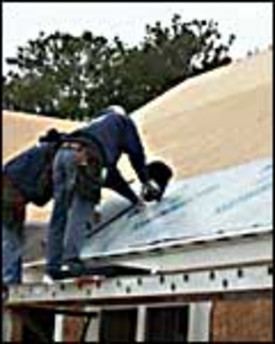Roofing underlayment was originally used for temporary protection against the elements but is now an integral part of a home’s overall roof system. Underlayment provides a vital second layer of protection on top of the sheathing to help keep moisture out. It is necessary for roofing manufacturers’ warranties and is now considered a necessary piece of the roofing puzzle. State and municipal codes require roofing underlayment for the system to meet standards like fire resistance, wind uplift resistance, puncture resistance, and resistance to wind-driven rain.
The choice of one underlayment over another depends on a number of conditions, including its application, whether it will be used on a steep or low-slope roof, the fire code requirements in place, and in what region the structure is located. Fortunately for consumers and roofing contractors, there are many underlayment manufacturers on the market. Underlayments fall under three basic categories: felts, synthetics, and self-adhering ice-and-water barriers.
Asphalt-Saturated Felt—The Grandaddy of Underlayments
Also called builder’s felt or felt paper, asphalt-saturated felt has been covering roofs for more than 50 years. The felt is made of a paper base that is impregnated or saturated with asphalt to make it more resistant to the elements. Some papers are actually coated in asphalt, while others are truly saturated. Roofing paper or felt is rolled across a roof deck and stapled or nailed in place. Builder’s felt differs by weight and may be No. 30 or No. 15 felt, a reference to the original weights of each underlayment. "The name changed because today’s 15 lb. felt is actually lighter than it used to be, because of modern technology and production," says Joan Crowe, technical manager of the National Roofing Contractors Association in Illinois. Although inexpensive and fairly easy to install, felt paper can be susceptible to tearing, especially in hot temperatures, and makes for a slippery surface to walk on while installing the roof covering. Asphalt felt also tends to trap moisture within the roofing system since it does not breathe.
Synthetic Underlayment—A Growing Trend
Much newer to the market are the polypropylene underlayments that are making waves in the roofing world. Made of synthetic polymers, the exact composition of these underlayments varies from manufacturer to manufacturer and remains strictly proprietary. These synthetic underlayments are marketed as wrinkle-free, tear resistant, and safer for workers to walk on during installation. "Synthetic underlayments are generally more durable than asphalt-saturated felt," explains Crowe. They are more expensive than felt, but it may be that you get what you pay for.
"Synthetic underlayments are more breathable," says Tom Jones of Stevens Roofing Corp. in Norfolk, Virginia. "They are waterproof, but they also allow moisture to pass out of the system." As a result, synthetic underlayments are mold resistant. They are lighter weight than felt papers, are lighter in color for a cooler roof, and are typically sold in greater widths and lengths. This translates into labor and time savings for roofing contractors.
Self-Adhering Underlayment
Self-adhering underlayments were initially used primarily in New England, where ice damming threatens roof integrity. These self-adhering ice-and-water barriers were installed mainly in the valleys and eaves of the roof, where ice damming tends to occur. An ice-and-water barrier is significantly thicker than felt or synthetic underlayments, is seamless, provides top-rate water protection, and requires no fasteners for installation. When an ice-and-water barrier is used in a roofing system, it is applied as a first layer, with the felt paper or synthetic underlayment applied on top, across the entire roof deck. These self-adhering underlayments are designed to seal up around any nails or staples used to install the felt paper, synthetic underlayment, or roof shingles. "Self-adhering underlayment works great on low-slope applications where water tends to pool up, says Jones." The underlayment does not allow the water to seep through."
Complete Systems—A Growing Trend
Warranty is a key word when it comes to roofs. Depending on location, a high-end slate or metal roof might cost as much as $400 per square (10 feet by 10 feet) to install. This is a hefty chunk of change to dish out at one time. Homeowners want to know that a manufacturer will back up the product with a warranty and that a roof said to last for 30 years will actually do so or be replaced. Manufacturers are now marketing complete roofing systems, which allows them to offer longer and more-comprehensive warranties. "Manufacturers want you to buy their whole package, including weather barrier, underlayment, and shingles," Crowe says. "If you use the whole package, you’ll get the total warranty."
While the definition of total warranty will vary from manufacturer to manufacturer, the phrase is enough to convince most roofing contractors to buy into it. "When we do a roof, we tend to go by the manufacturer’s recommendations and use their complete system," Jones says. "That way we know we can go back to the manufacturer if there is a problem with the roof later on, because they’ve provided a bit more extended warranty."
Marketing trends aside, the advancements being made in roofing systems and roofing underlayments are leading to stronger, longer-lasting roofs that hold up better against the worst that nature has to offer. "The new technologies have solved a lot of problems," Jones says. "These advancements are good for the industry."
Credit: Renovate Your World




























